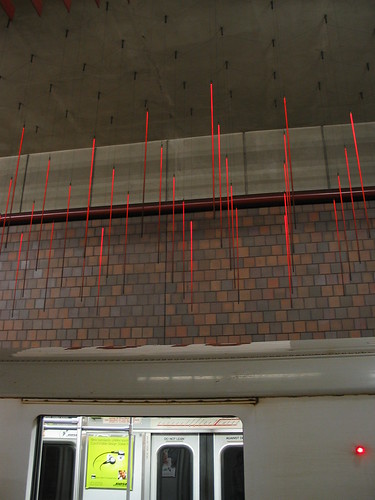The model is straight forward - a user specified number of agents are chosen to receive the evacuation notice. Every cell is randomly assigned a decision value that represents the likelihood that they'll actually leave. If that value is above some threshold, then the cell decides to evacuate (represented by green), otherwise they'll stay (red). The blue cells haven't heard one way or the other about the evacuation.
Next all the cells look at their neighbors and see if they've received the evacuation notice - if they haven't nothing changes. If their neighbors have made a decision it will affect the previous mentioned decision value either positively (if their neighbor is evacuating) or negatively (if their neighbor is staying put).
What we see is that there are random cells throughout the region that decide to stay - and also larger clusters (neighborhoods).
It is a very simple model - but I think it captures some of the dynamics of this process. Here is a link to the model: http://www.acsu.buffalo.edu/~mjwidene/evacmodel.nlogo (NOTE: Right click and save as - otherwise you'll get text. Also you need Netlogo to run the program).
And for those interested here is the code:
patches-own [aware? prob-evac evacuate? influence no!]
to setup
ca
ask patches[
set aware? 0
set pcolor blue
set prob-evac random-normal .5 .3]
repeat num-initial[
ask one-of patches[
set aware? 1
set pcolor orange]]
setup-initial-decision
end
to setup-initial-decision
ask patches with [aware? = 1] [
ifelse (prob-evac > .5)
[set evacuate? 1
set pcolor green]
[set evacuate? 0
set pcolor red]
]
end
to go
display
ask patches[
if (prob-evac < .1)
[set no! 1
set pcolor red]
look-at-neighbors
make-decision
]
end
to look-at-neighbors
set influence (count neighbors with [evacuate? = 1])
if (no! = 0)[
set prob-evac (prob-evac + .3 * (influence / 8))]
end
to make-decision
ifelse (count neighbors with [evacuate? = 1] != 0)
[ifelse (prob-evac > .5)
[set evacuate? 1
set pcolor green]
[set evacuate? 0
set pcolor red]]
[if (prob-evac > 0.1)
[set prob-evac (prob-evac - .1)]]
end





